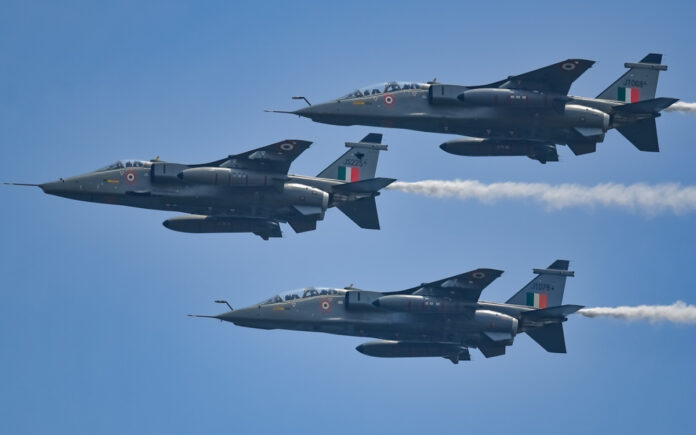Washington: An intense aerial encounter between French-made Indian Rafale fighters and Chinese-built Pakistani J-10 jets is drawing the attention of global military analysts, offering rare real-time data on modern air combat and missile performance.
According to two U.S. officials speaking to the international news agency Reuters, Pakistani fighter jets shot down at least two Indian aircraft on Wednesday. The incident marks a potentially significant moment for China’s defense exports, particularly its J-10 platform, and provides live combat insights into the effectiveness of advanced air-to-air missile systems.
The dogfight is being studied closely by defense establishments in the U.S., China, and Europe, especially given the increasing geopolitical tensions surrounding Taiwan and the Indo-Pacific region. With limited opportunities to test such weapons in real warfare scenarios, militaries are keen to dissect what transpired—analyzing the performance of pilots, aircraft platforms, and advanced missiles.
One U.S. official, speaking on the condition of anonymity, confirmed a “high confidence” assessment that Pakistan deployed Chinese-made J-10 jets equipped with air-to-air missiles during the clash. Though neither side has officially disclosed the specific weapons systems used, online discourse has centered on China’s PL-15 missile and Europe’s Meteor missile—a high-tech radar-guided weapon produced by the MBDA consortium.
“Air warfare communities in China, the U.S. and a number of European countries will be extremely interested to try and get as much ground truth as they can on tactics, techniques, procedures, what kit was used, what worked and what didn’t,” said Douglas Barrie, senior fellow for military aerospace at the International Institute for Strategic Studies.
“You have arguably China’s most capable weapon against the West’s most capable weapon, if indeed it was being carried; we don’t know that,” Barrie added.
With uncertainty surrounding what was actually deployed, French and American defense stakeholders are likely hoping India will share more granular information. As one defense industry executive noted, “The PL-15 is a big problem. It is something that the U.S. military pays a lot of attention to.”
Both Dassault Aviation, the manufacturer of the Rafale, and MBDA declined to comment or could not be reached—partly due to a public holiday in France.
Limited Public Information Spurs Analysis Frenzy
Despite the growing attention, many critical details remain murky. It’s unclear whether India’s Rafale fighters carried the Meteor missile during the engagement, or what kind of training the pilots had prior to the clash. Western arms manufacturers are particularly focused on distinguishing whether any observed performance differences stemmed from technical limitations or tactical decisions.
“There will be audits of what works and what doesn’t work, but I think the other overlay is the proverbial fog of war,” said Byron Callan, a Washington-based defense expert and managing partner at Capital Alpha Partners.
He explained that U.S. defense firms are already adapting based on constant feedback from weapon performance in the war in Ukraine. “So I absolutely expect the same to be the case with India’s European suppliers, and Pakistan and China are probably sharing the same feedback. If the PL-15 is working as advertised or better than expected, the Chinese would like to hear that.”
A defense industry source from a Western country that uses the Meteor pointed to an online image of a missile seeker, suggesting it might have missed its target. The same source also questioned whether Pakistan’s J-10s were equipped with the domestic PLAAF version of the PL-15 missile or the lower-range export version unveiled in 2021.
Also Read | Trump Hints at Easing 145% Tariffs Ahead of U.S.-China Trade Talks
Barrie, who has researched the missile extensively, said he believes Pakistan is most likely using the export version of the PL-15. While some in the defense community believe the PL-15 could outrange the Meteor, one Western industry expert pushed back on those claims, saying the rocket-powered PL-15’s capabilities might be slightly overestimated but “may be greater than was thought.”
Currently, the Meteor’s exact range remains classified, further complicating any definitive comparisons.
Implications for Future Conflicts and Weapon Development
The growing attention around the PL-15 comes as Western nations reassess their priorities in response to China’s military advances. The missile, which marked a turning point in Beijing’s shift away from Soviet-era designs, has long been a focus for Western defense analysts.
The U.S. is developing its own answer in the form of the AIM-260 Joint Advanced Tactical Missile, designed by Lockheed Martin, to match or exceed the beyond-visual-range (BVR) capabilities of the PL-15.
Meanwhile, European defense planners are mulling a mid-life upgrade to the Meteor missile, with potential enhancements in propulsion and guidance. However, experts note that progress has been slow, and the recent combat encounter might prompt renewed urgency.
Also Read | Trump Advocates Higher Taxes for the Rich to Fund Working-Class Cuts
In March, U.S. President Donald Trump awarded Boeing the contract for what is expected to be the U.S. Air Force’s most advanced fighter yet—featuring stealth capabilities, next-generation sensors, and highly efficient engines, likely tailored to counter threats like the PL-15.
As the dust settles on the India-Pakistan clash, its strategic significance is expected to echo through military planning rooms across the globe for months, if not years, to come.



